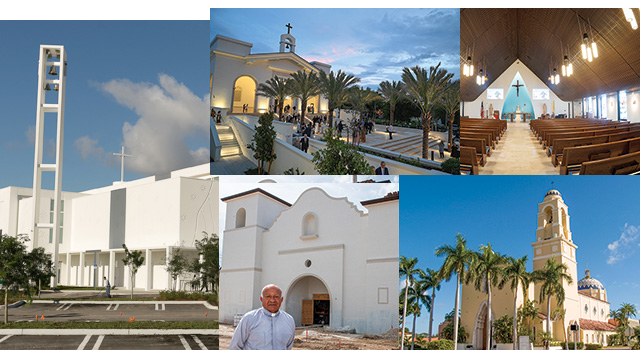By Rocio Granados - La Voz Catolica
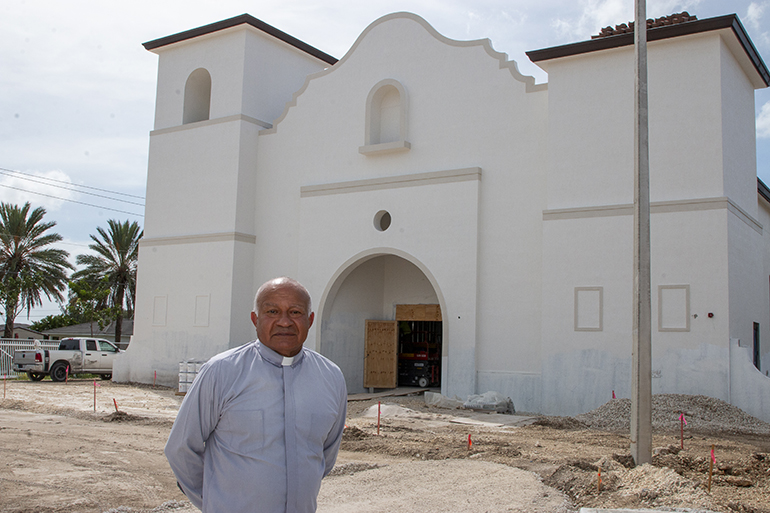
Photographer: ANA RODRIGUEZ-SOTO | FC
Father Rafael Cos, administrator, stands in front of the new church of St. Ann Mission in Naranja Oct. 12, 2023, which is set for completion sometime in February 2024, and is faithful to the architectural style of the original church.
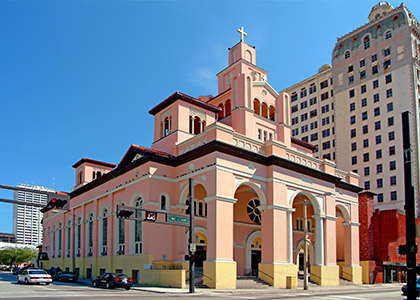
Exterior view of Gesu Church in downtown Miami, which was founded along with the City of Miami in 1896.
MIAMI | Next time you walk into church, look around. Notice the shape of the building, the artwork inside it, the location of the altar, even the view from the pews. Nothing is there by accident. Everything was meticulously planned and calculated long before a single brick was laid.
Throughout its 65 years of existence, the Archdiocese of Miami has overseen the building of many churches. Among the most prominent are St. Mary Cathedral in Miami; the Basilica of St. Mary Star of the Sea in Key West; the National Shrine of Our Lady of Charity in Coconut Grove; Gesù, the oldest church in Miami, built in 1896; and more recent and modern constructions such as Our Lady of Guadalupe in Doral; St. Peter in Big Pine Key; the recently consecrated St. Agnes in Key Biscayne; and the currently under construction St. Ann Mission in Naranja.
While some dioceses are shuttering churches, the Archdiocese of Miami continues to build new ones.
"It is a blessing for those of us who live in Florida. The Hispanic community, which is very strong, keeps the Church growing with its support and drive. The Catholic tradition, handed down from parents to children, is very much in evidence," said David Prada, senior director of the Archdiocesan Office of Building and Property.
But how do you go about building a church?
According to the Code of Canon Law, a church is a sacred building destined for divine worship, which the faithful have the right to enter for the celebration, especially public, of divine worship.
To build a church, "one begins with the need of the community, and the pastor requests it from the archbishop," Prada explained.
When the archbishop gives his approval, the archdiocesan offices of Worship and Building call on an archdiocesan committee to help guide the process. The committee is composed of experts in liturgy and architecture as well as parish priests with experience in church construction.
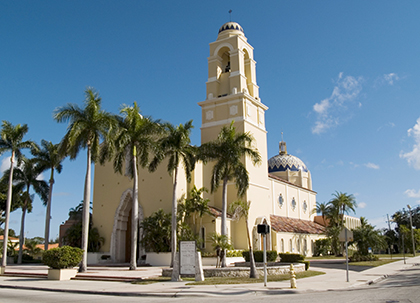
Exterior view of St. Mary Cathedral in Miami.
The parish establishes its own committee, made up of parishioners invested in the charism and history of that church. They often have experience in architecture, finance or construction, "but most of their help is simply praying for the project," said Prada.
This committee is also in charge of selecting the architect who will design the project. The Office of Worship, under the direction of Father Richard Vigoa, ensures that the design complies with the norms of liturgy and sacred art.
NEED TO BUILD
The reasons for building churches are diverse. There may be a parish with no permanent church, as was the case with Our Lady of Guadalupe, which was dedicated in 2015, 14 years after the parish was established. On the other hand, St. Agnes "already had a church for 400 people, but the building was too small to accommodate more," said Prada. The structure also did not meet current flood codes, so it made more financial sense to demolish it rather than expand it.
The design of the new church is the responsibility of the architect selected to carry out the project. The design should take into account the requests of the parish but "we also let ourselves be guided by the spirit of the architect, who must understand what we want to achieve," said Prada.
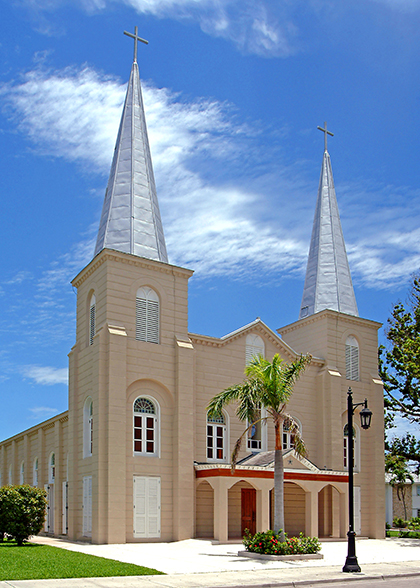
Exterior view of the Basilica of St. Mary Star of the Sea in Key West.
Catholic churches are characterized by tall towers and domes, colorful stained-glass windows and religious sculptures. In fact, the exterior should be instantly recognizable as a Catholic church. Our Lady of Guadalupe, for example, has a huge image of the Virgin of Guadalupe that is visible from the Turnpike; the exterior walls are covered by symbols from the Virgin's mantle; and the building is shaped like a cross, visible to travelers arriving and departing from Miami International Airport.
Inside, all church details must be at the service of the liturgy. The Worship Office "makes sure that this vision is being maintained and not lost in the process," Prada explained.
The interior must have an altar, a tabernacle for the Blessed Sacrament, a baptismal font, confessionals, a space for the choir, a sacristy, pews for the faithful and restrooms. It also may include a space for families with small children and a chapel.
Religious art, which is very important to Catholics, must also "be at the service of the liturgy and the parish; that's where the charism of the parish comes in,” Prada said.
At St. Agnes, for example, the company that won the bid outlined a vision: to tell the story of how a girl from Rome became a saint. That vision included the statue of a young St. Agnes standing in the entrance plaza.
"You can see that she is a very strong young woman, standing in a traditional position used by Michelangelo, called Contrapposto — non-moving — because her faith was immovable," Prada said.
The sculpture was created by Nilda Comas, a local artist who also made the crucified Christ in bronze and the marble statue of the Virgin of Guadalupe for Our Lady of Guadalupe.
NEW TECHNOLOGIES
New technologies have helped with the construction of churches, Prada said. In centuries past, it took many years to build a church. Today, churches in the Archdiocese of Miami are built in months. Modern materials also are more resistant. In places like South Florida, which suffers the scourge of hurricanes, impact glass helps protect the interior of the buildings.
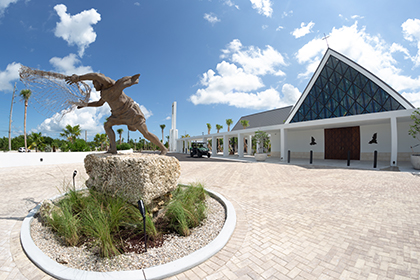
Photographer: TOM TRACY | FC
View of the main entrance to the new St. Peter the Fisherman Church in Big Pine Key a few hours before the dedication Mass, Sept. 25, 2021. The newly completed church, parish hall and priests' residence in the Lower Florida Keys replace the old facility which was mostly destroyed by 2017’s Hurricane Irma.
Flooding is also an issue here, so the floor level of St. Agnes Church in Key Biscayne was raised with the help of technology. "In the event of a flood, the water will flow under the building, where the parking lot is located," said Prada.
At St. Peter, also located on an island in the Florida Keys, "there was more room to raise the floor level of the church, but they made vehicle ramps instead of having the parking underneath," explained Prada, an architect who holds a Leadership in Energy and Environmental Design accreditation from the U.S. Green Building Council.
Prada also noted that modern technology helps to save electricity, with roofs that reflect the sun and do not absorb heat. The ability to craft curved pews provides greater comfort to the faithful during Masses – since they can sit around the altar rather than off to the side – as do materials such as steel that preclude having columns that interrupt the view of the altar.
An example of this fusion of old form with new materials is Our Lady of Guadalupe, which from the outside looks modern, but inside is a cross-shaped building in the traditional form of a Roman basilica.
"Its altar is in the center; it has a central nave and two smaller ones on the sides. It also has an elevated center and the two sides are lower, with the arch," Prada explained.
St. Agnes also features a traditional vaulted design. "It has several arches that intersect, but contemporary."
"It's very interesting to me, as an architect. In the new buildings we are not just tied to the traditional design, but we use modern materials and technologies that allow these traditional forms to be implemented in the best possible way today," said Prada, who has been involved in the construction of five new churches since he began working at the archdiocese in 2012.
The project he is currently involved in is the construction of St. Ann Mission, which is being carried out in two phases.
The first phase, recently completed, included the construction of parish offices, classrooms for religious education, and a food and clothing distribution center for persons in need. The second phase is the church itself, which is tentatively scheduled to be dedicated in March.
The building is shaped like a California mission because of its name and the characteristics of its faithful, mostly farm and construction workers in the Homestead area. The project was made possible by a generous donation from a local Catholic who is now deceased, as well as support from the archdiocese.
Learn more about "how to build a church" on the podcast, What the Faith, Miami?.

Photographer: TOM TRACY | FC
Members of the community were on hand at St. Agnes Parish in Key Biscayne for an evening Mass Sept. 15, 2023, during which Archbishop Thomas Wenski dedicated and consecrated the parish's new church.
